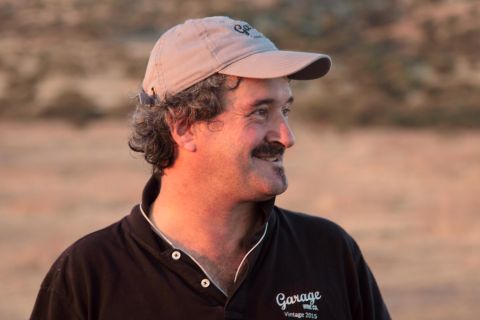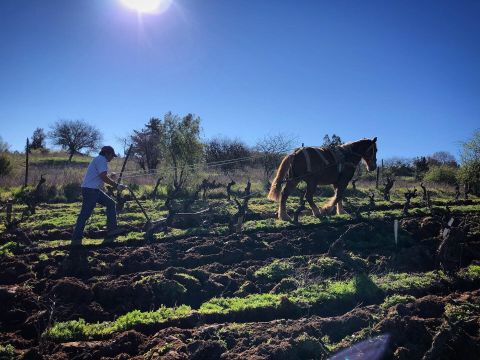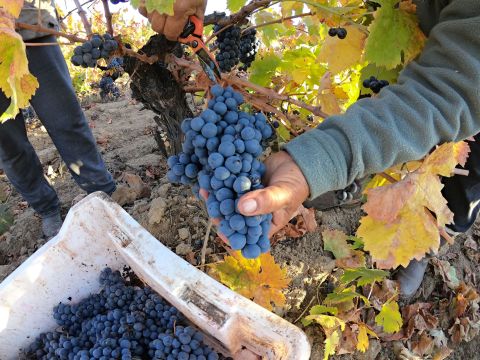The heart and soul of the Truquilemu vineyard
“Just imagine such old vineyards, passed down over almost 20 generations, today suffering from neglect. Not because they stopped making wonderful wine, but because the vineyards simply don’t interface with the modern world.” So explains Derek Mossmann-Knapp during our most recent conversation about their ventures in Chile’s Secano Interior.
Those who have had the pleasure to meet Derek will know that he is one of the most passionate (and I don’t use this word lightly) and exuberant proponents for protecting old vines and supporting local communities. Through their Garage Wine Co., Derek and his winemaker wife, Pilar Miranda, focus on reviving old vineyards in marginalised Chilean communities to make award-winning, individual, and often limited bottling wines.
One such vineyard – and there are many to choose from – is in the Maule Valley. Truquilemu is, according to Derek, perhaps in the freshest corner of the Maule, located high on the Coastal Range of mountains where reds only just manage to ripen. While it is officially 75 years old, with documentation stating it was planted in the 1940s, local opinion is that this was when the vineyard was first registered with authorities, not when it was planted, and that it is in fact much older. Derek explains, “There are men of 80 years old who worked on the farm as teenagers, who tell us it was old and gnarly when they began working in the vineyard.”
Covering about 4.5ha in total, the vineyard has various owners, most of them cousins. Derek and Pilar rent 2ha of these on a long-term basis, where the next generation had moved to the city, while they also work in a long-term partnership with another grower who owns a further hectare. “When the fundo was broken up in the 60s with agrarian reform, the administrator (of a much larger fundo) ended up with the piece of land that included the vineyards and the smaller of two colonial adobe homes, from where it was subsequently divided up between his heirs,” explains Derek.
These old bush-head vines are a field blend of mostly Carinena, with Monastrell (which the Garage team grafted on Pais roots), Pais, Malbec and Negramoll. “No one knows why so much Carinena (very rare back then) was planted in one place,” says Derek. “Usually, it was dosed out among the Pais to lend more colour, acid and structure to simpler country wines.” Which is exactly what these grapes were used for before Derek and Pilar discovered this piece of land in 2008.
Old vines, ‘old’ hands
Working with these old vines is both a privilege and a challenge, which is where the importance of people come in. Empowering small, marginal communities is part and parcel of Derek and Pilar’s entire philosophy. And it’s a win-win situation. Derek explains, “As wine has boomed in Chile over the last quarter century, it has grown increasingly difficult for these small growers to sell their grapes at a bona fide price. Large buyers want more for less and they would have the small modernise: spray instead of cultivate, scale instead of focus, and most of all, reduce labour costs.
“We disagree with this pushing aside of age-old field craft and the wisdom of farming down the ages. We think proper farming is being undermined by speculation and livelihoods are threatened not by ‘market forces’ but by disconnect. Where do the buyers think the flavour comes from anyway?”
For Derek, the ‘flavour’ comes from the wisdom of these ‘old’ hands. “The vignerons here work amongst us to cultivate the vines. They work with horses and plow the land. These vignerons have farmed the Secano for centuries, and not just their vineyards, but mixed farms of heritage seed wheat, free range livestock, and local market gardening.”
But it’s about more than just keeping local people in work. Together with their Swedish importers, Handpicked Wines, Garage have recently launched a project called ‘Revival’. This aims to help keep labourers working safely during the Covid-19 pandemic, by creating what they call a ‘revival bubble’.
And this isn’t the first such project. Following the devastating 2010 earthquake in Chile, Derek went on a mission to seek out old-vine Carinena in Maule. He discovered some amazing, but untamed vines, and worked with these local farmers to improve their vineyards and livelihoods, while using the grapes to make wine under the Garage Wine Co. label.
In January 2017, disaster struck again when the worst wildfires in Chile’s history ravaged the country. Despite acres of land destroyed and the looming impact of smoke taint on ripening grapes, Derek decided to craft something beautiful out of the destruction. And so, on the heels of these fires – and quite literally out of the ashes – he created the first of the Fieldcraft bottlings, called Phoenix. This special, limited bottling white wine is a blend of Pais and Carinena, which was sold in limited quantities to the UK On Trade.
In the glass
But back to the old vines of Truquilemu. The soil is full of crystals and decomposed granite, and being the freshest corner of the Maule, Mediterranean reds only just manage to reach alcohol levels of around 12.7 to 12.8%. “They must have made some pretty terrible, green wines for many years when they were first planted!” he quips.
There are three distinct sections. About a dozen long rows are used for their Old Vine Pale, while the rest is used in the Truquilemu Vineyard (2018 Lot 97) and the Cru Truquilemu. The Old Vine Pale is, as the name suggests, somewhere between a light red and a rosé, and was the perfect solution for a more vigorous section of this vineyard – despite initial objections from Pilar, at a time when they were solely a red wine cellar. Derek also tells the story of how they were convinced to produce this wine more commercially by an unnamed travelling winemaker during a visit some years ago… but that is a story for another day.
Regardless – and thankfully, as it is absolutely delicious – the Old Vine Pale was born. With access to more water, these 12 rows at one end of the Truquilemu vineyard are more vigorous, and the grapes are cut earlier, at about 1.5 to 2kg yield per plant. “After years trying to tame them, we simply made the wine that the vines were screaming to make,” he says.
Traditionally (or as Derek puts it, ‘ancestrally’) farmed by hand and horse, the juice is naturally fermented with native yeast, without skins, in two parts. One part of the blend is pressed like a white, while the other is made like a red wine without skins. Aged in older (four years plus) barrels over one winter, they only produce around 3,800 bottles a year.
So, is it rosé or a light red? For Derek, it’s “a proper first glass of a long Chilean lunch.” He says, “This wine is not made for the swilling of summer. We initially released it in the fall, just when the low budget rosés get put away. The 2020 vintage is crisp and austere, made to be imbibed over a few years’ time. We have bottles of the early vintages and perhaps due to the wine’s tremendous acidity (3,0 pH) it not only keeps its freshness, but it develops complexity and pleasantly surprises for years to come.”
All in all, a delicious and unique wine from ruggedly beautiful and gnarly old vines in the heart of the unassuming Maule. Compared to many old vines that sadly get the axe for various reasons, this vineyard is one of the luckier ones. Through its 75+ years of existence it has suffered many a frost and mildew infection, while sections of the Pais and Carinena were neglected and got burned in the wildfires of 2017. But it survived and has been revived. Why, I ask Derek? “Because it makes great wine. Old vines don’t make good wine because they are old, they are old because they make good wine.”
Photo credit: Garage Wine Co.
















